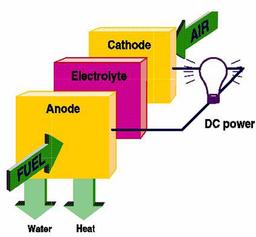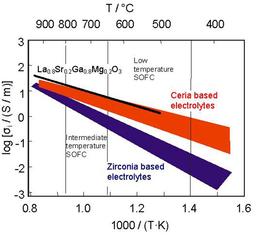|
|||||||||||
Thin Film Solid Oxide Fuel Cells
Contact: Daniel Beckel, Ulrich Mücke or Jennifer Rupp
In a solid oxide fuel cell (SOFC) air enters the cathode side of the cell and, after reduction, oxygen ions cross the electrolyte. On the anode side the fuel is oxidized and water is formed together with the oxygen ions. During this process heat and electricity are generated.
Today, one of the challenges in the field of SOFC is to reduce the operating temperature from the order of 950 °C to around 600 °C in order to reduce costs and to increase the reliability of SOFCs. One of the problems that has to be overcome is the lower conductivity of traditional SOFC materials (e.g. yttrium-stabilized zirconia electrolytes) at lower operating temperatures. Different materials, therefore, need to be found for that purpose. For example, gadolinium doped ceria can be used for the electrolyte, as ceria-based electrolytes show a higher ionic conductivity (sigma(i)) than zirconia-based electrolytes at lower temperatures.
For the cathode lanthanum strontium cobalt iron oxide (LSCF) is an appropriate material for low operating temperatures, since it offers both, electronic and ionic conductivity, which is needed for a cathode. In addition, LSCF offers enough catalytic activity for oxygen reduction, which is also essential for a cathode.
Besides catalytic activity towards fuel oxidation, the anode has to exhibit ionic and electronic conductivity. This can be achieved by a nickel – gadolinium doped ceria (Ni – CGO) anode.
The second important step to reduce resistance is to use thin film (around 1 micrometer) electrolytes and electrodes which can be obtained by spray pyrolysis. With this technique, the size of the fuel cell can be reduced, and therefore a micro fuel cell can be built. Such a small fuel cell could replace batteries in many applications where a longer operating time is needed. Combining high performance materials and the process of spray pyrolysis should lead to an SOFC with high power density even at low temperatures.
Wichtiger Hinweis:
Diese Website wird in älteren Versionen von Netscape ohne
graphische Elemente dargestellt. Die Funktionalität der
Website ist aber trotzdem gewährleistet. Wenn Sie diese
Website regelmässig benutzen, empfehlen wir Ihnen, auf
Ihrem Computer einen aktuellen Browser zu installieren. Weitere
Informationen finden Sie auf
folgender
Seite.
Important Note:
The content in this site is accessible to any browser or
Internet device, however, some graphics will display correctly
only in the newer versions of Netscape. To get the most out of
our site we suggest you upgrade to a newer browser.
More
information



